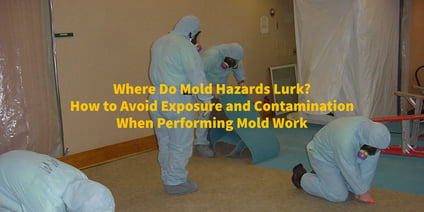Asbestos has been used sporadically throughout human history because of its well-known fire-proofing qualities and durability as a construction material. This white, fibrous mineral can be found in Pliny the Elder's writing and was used as snow to blanket Dorothy and her friends in The Wizard of Oz. Little did the actors know at the time that this practical effect used during the poppy field scene to wake Dorothy and her friends up from the spell cast by The Wicked Witch was incredibly dangerous to their health (if you want to watch the asbestos blankets the characters it starts at 3:05 in the video below).
Asbestos was also used in many Christmas decorations in the early 20th century, including fake snow.

During the Industrial Revolution, Asbestos production ramped up as numerous companies sought to cash in on the mining and production of the lucrative insulation material.
The commercialization of asbestos brought countless employees into direct contact with asbestos dust. As exposure increased, the evidence became increasingly clear that exposure led to asbestosis and lung disease. In the 1930s it was indisputable that asbestos caused lung cancer and pathologists began to recognize patterns of lung disease that worked with asbestos fibers.
In 1928 a case of pulmonary fibrosis was discovered in a Glasgow factory and Edward Merewether, a young medical inspector, was called in to ascertain whether asbestos exposure could be definitively linked to future lung disease.
According to a paper published by The British Medical Journal, "At 36 years of age, Merewether was comparatively young when he embarked upon this task. He was also a newcomer to the inspectorate, having taken up his appointment only in 1927. Merewether’s initial survey was soon followed by a full-scale investigation, which he completed in October 1929. He found that occupational exposure to asbestos dust, particularly for prolonged periods at high concentrations, constituted a “definite occupational risk among asbestos workers as a class”.21 The fibrosis of the lungs that could result might lead to “complete disablement” and death.21 His report endorsed a view expressed a few months earlier that a “new” disease, pulmonary asbestosis, had been discovered."
It wasn't until the 1960s that Dr. Irving Selikoff linked occupational exposure to cancer and other hazardous health conditions. This declaration came during an organized coverup among asbestos-producing companies that put profit over documented health effects of the toxic substance. The first lawsuits against asbestos products in the U.S. occurred in 1971, and the industry is now heavily regulated, (although asbestos continues to be produced and exported in Russia, Kazakhstan, Brazil, China, and India and is still used for cheap building materials).
In the United States, asbestos is heavily regulated by the EPA but is not outright banned. Banned products include spray-applied asbestos, asbestos wall patching compound, asbestos artificial embers, and asbestos filters in pharmaceuticals.
How Exposure to Asbestos Occurs
The history of the use of asbestos is directly linked to the prevalence of the material today. Many homes built before 1980 used asbestos as an insulation material in ceiling and wall plasters, vinyl floor backings, wallboard, floor mastics, wallboard, floor and ceiling tiles, and other places. Most of this asbestos presents no danger as long as it remains intact and undisturbed.
When asbestos-containing materials are damaged or disturbed fibers can be released into the air. These carcinogenic fibers are extremely toxic to health. When they are inhaled they can become trapped in the lungs. Repeated exposure can result in chronic lung disease and a condition known as asbestosis.
Any contractor that does work that can expose them to asbestos needs to take the proper precautions to keep everyone surrounding the job site safe.
They have also created standards to protect workers that might come into contact with the pollutant on a daily basis. Employers at these job sites must ensure that their employees are not exposed to a level of asbestos above the PEL and must conduct an exposure assessment before work begins.
There are two general types of asbestos that contractors can encounter:
Non-friable Asbestos
Material that contains asbestos reinforced with a bonding compound is called non-friable asbestos. An example of this would be asbestos cement sheeting.
Friable Asbestos
This is the powdery form of asbestos. Friable asbestos is typically found in pipe lagging and is very common in the United States.
https://www.asbestos.com/featured-stories/cover-up/
Contractors performing asbestos abatement must establish proper containment first before removing any asbestos. Proper asbestos abatement is governed by strict regulatory procedures that must be properly adhered to. This article won't cover the abatement process and will instead focus on the importance of proper containment and the products you will need.
What Is the Purpose of Containment?
Containment constitutes the foundation of any successful abatement job. The purpose of containing an asbestos-contaminated area is to seal off the contaminated area from the rest of the building while working. Dry asbestos fibers are microscopic (they can be as small as 7 microns) and can easily become airborne. It's imperative that asbestos does not spread through the rest of the building. By constructing a proper containment zone, you ensure that asbestos doesn't leave the contained area.
In the following video, you can watch the construction of a containment zone. My favorite thing about the video is how it illustrates the meticulous attention to detail that a contractor must give when building an airtight seal from plastic sheeting.
OAI, Inc. students demonstrate how to build an Abatement Enclosure for Asbestos.
The Products Required for Containment on an Asbestos Abatement Job
Workers participating in any abatement activities must adhere to strict guidelines set forth by the Environmental Protection Agency (EPA) and OSHA.
Part of this includes having all of the products needed for containment:
Respirators that are in compliance with OSHA standards
Any job that involves hazardous pollutants or materials that can be breathed in requires proper respiratory protection as covered in this article. Asbestos fibers are very fine and are easy to inhale. A mask should be fit properly (pass a fit test) and should have a HEPA filter that can filter fine particles.
Clear Poly Sheeting
As shown in the above video, clear poly sheeting is the primary material used for constructing a containment barrier. The sheeting material is non-porous and provides a dust and vapor barrier that prevents asbestos from leaving the containment zone.
Raptor Grip Poly Tape
A containment zone must be held together with durable material. Poly sheeting must be taped firmly and securely in order to remain secure and intact throughout an asbestos job. The adhesive quality of the tape provides a strong bond that maintains its strength in a variety of temperatures.
HEPA Air Scrubber
Asbestos fibers are incredibly small and have a diameter of only 0.7 to 0.9 microns. HEPA filters are capable of removing particles above and below 0.3 microns, making them an essential tool for any abatement job. Negative air pressure must be created inside of a containment zone to prevent any asbestos from escaping. The right amount of clean air changes will protect your employees, prevent air from leaving the contamination zone, and prevent anyone in the rest of the building from being exposed to pollutants.
Disposable Coveralls
Working in an area that contains asbestos exposes your body to harmful fibers. It's important to keep them off of your skin and keep them from getting outside of the contaminated area. Many contractors wear two suits. The outer suit must always be removed and disposed of in an asbestos waste bag before leaving the work zone and moving outside of the contaminated area. Disposable Coveralls should never be reused or recycled.
Disposable Gloves
Gloves prevent your hands from coming into contact with asbestos and protect them from other injuries that can occur in the workplace. Gloves should be disposed of in an asbestos waste bag before leaving your work area. Gloves should never be reused or recycled.
Disposable Shoe Covers
Disposable shoe covers are used to create a seal around the rest of your PPE so that asbestos does not get into your coveralls. Disposable shoe covers should never be reused or recycled.
Labeled Poly Bags to Dispose of Asbestos
All asbestos material must be disposed of in 6-millimeter bags that are durable and have a warning label that they have asbestos-containing material (ACM).
Decon Shower
Before exiting the wok era, you must take a shower to remove any remaining asbestos that has gotten on your skin or body. This should be done after removing all other PPE besides your mask. While showering, you should clean all parts of your mask besides the filter. Make sure that the shower is clean and well-maintained.
Asbestos Warning Signage
To comply with OSHA guidelines you must post a sign outside of the work area that designates it as an area where people can be exposed to asbestos.
Conclusion
Asbestos is a very dangerous pollutant. There is no shortage of abatement work that needs to be performed, especially with all of the old houses and building materials that were built with the material.
It's much better to overprepare when performing an abatement job. It's vital that you have all of the right equipment before beginning a job that carries a potential health risk. This will reduce job site hazards and boost the confidence and morale of your employees.
*None of the information in this article is intended for nor constitutes legal advice
Enjoyed reading this post? Read the following articles:




